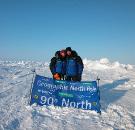 |
||||
OUR JOURNEY …Arrival Date at the Pole: 20th Aprill 2005 BACKGROUND …The North Pole is about 725km north of Greenland in the middle of the Arctic Ocean and although most of the time sea ice covers the location of the pole, in recent years water has been seen there. Historically, Robert Peary and his partner Matthew Henson plus four Inuit are generally believed to have reached the North pole first in April 1909. However, there is much debate about whether they in fact missed it by a few miles. However, all the time you are journeying towards the pole, you are also drifting on the ice pack itself (and maybe annoyingly away from the pole at that!), so it is not difficult to imagine that you might miss the pole by a few miles especially without the luxury of GPS to use when the sun isn’t visible in bad weather! As with the South Pole there is more than one North Pole (e.g. geographic North Pole and the magnetic North Pole). The most well known and often referred to is the geographic North Pole which has a latitude of 90 degrees north. When people speak of travelling to the pole they are normally referring to the ‘Geographic’ pole. The North Pole is the most northerly point on the earth’s surface and is also known as ‘true north’. At the pole, all the lines of longitude converge which makes all the time zones very close as you approach the pole and you can cross the zones very quickly, even on foot ! When standing at the geographic North Pole, east and west do not exist and all points are south of you. In comparison to the equator where the earth is spinning at over 1600 kilometres per hour, at the pole there is virtually no rotational speed at all. Unlike the South Pole the North Pole is located on a sheet of ice which floats on a sea of water around 4000 metres deep. Consequently there are no markers or base stations at the North Pole and the only way to tell where it is, is by GPS or by sun sights (in the absence of GPS), or, if it’s a cloudy but windy day - by the wind! |
|||||||||
 |
|||||||||
Site designed by |
|||||||||
|
 Latitude: 90 Degrees North
Latitude: 90 Degrees North